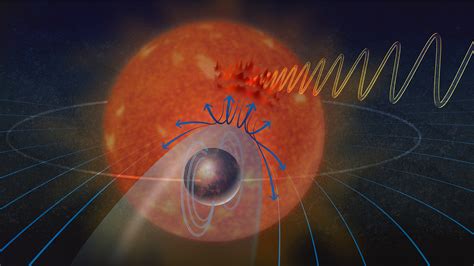Earth from the sun

WebMar 22, 2024 · Just slightly larger than nearby Venus, Earth is the biggest of the four planets closest to the Sun, all of which are made of rock and metal. The name Earth is … Earth is made up of complex, interactive systems that create a constantly … Saturn takes about 10.7 hours (no one knows precisely) to rotate on its axis … Uranus is about four times wider than Earth. If Earth were a large apple, Uranus … Phobos is the larger of Mars' two moons. It orbits Mars three times a day, and is so … More than 30 times as far from the Sun as Earth, Neptune is the only planet in our … The known icy worlds and comets in both regions are much smaller than Earth's … As Earth orbits the Sun, it completes one rotation every 23.9 hours. It takes … There are more planets than stars in our galaxy. The current count orbiting our … Mercury spins slowly compared to Earth, so one day lasts a long time. Mercury takes … Jupiter is the fifth planet from our Sun, and it's the largest planet in the solar … WebMar 14, 2024 · The subsolar point is an area where the sun's rays shine perpendicular to Earth's surface—a right angle. Only during an equinox is Earth's 23.5° axis not tilting toward or away from the sun: the perceived center of the Sun’s disk is in the same plane as the Equator. Before and after the equinox, the subsolar point migrates north or south.
Earth from the sun
Did you know?
WebSun-Earth Connection. The above image shows two examples of a coronal mass ejection (CME). The black disk blocks out the bright light from the Sun, creating an artificial eclipse so that the dim light from the CME can be observed. (The disk blocks out light from a region that is 1.6 times the diameter of the Sun.) Each row shows the evolution ... Web2 hours ago · A massive coronal "hole" in our sun that spewed energy towards the Earth in recent weeks. A video from NASA's Solar Dynamics Observatory shows the massive …
WebA solar neutrino is a neutrino originating from nuclear fusion in the Sun's core, and is the most common type of neutrino passing through any source observed on Earth at any particular moment. [citation needed] Neutrinos are elementary particles with extremely small rest mass and a neutral electric charge.They only interact with matter via the weak … WebOct 28, 2013 · We orbit the Sun at a distance of about 150 million kilometers. This number is actually an average, since we follow an elliptical path. At its closest point, the Earth gets to 147 million km, and ...
Web20 minutes ago · The Sun’s menacing solar flares are many times the size of earth. Massive geomagnetic storms can wreak havoc on our planet when solar flares eject CMEs (coronal mass ejections). Scientists have now been able to successfully replicate these solar flares in a lab, from the size of many earths to a man-made one that can fit inside a tiffin … Web2 hours ago · A stunning solar "waterfall" has been spotted on the surface of the sun. The picture, taken by astrophotographer Eduardo Schaberger Poupeau on March 9, shows a wall of plasma being shot "some 100,000 km" — or about 62,000 miles — up towards space, Poupeau told Spaceweather.com. That's high enough to engulf about eight Earths.
Web2 days ago · While Earth orbits the sun, the planet is simultaneously spinning around an imaginary line called an axis that runs through the core, from the North Pole to the South Pole. It takes Earth...
WebJul 5, 2024 · During this annual milestone, the Earth is 3,111,432 miles (5,007,364 km) farther from the sun than it was on Jan. 2, when Earth was at perihelion, its closest point to the sun for 2024; a ... recoil ground cablesWebEnergy from the Sun is the driver of many Earth System processes. This energy flows into the Atmosphere and heats this system up It also heats up the Hydrosphere and the land surface of the Geosphere, and fuels many processes in the Biosphere. Differences in the amount of energy absorbed in different places set the Atmosphere and oceans in ... recoil hack scriptWeb21 rows · 2 days ago · Earth, third planet from the Sun and the fifth largest planet in the solar system in terms of ... unt walk on footballWebAug 2, 2024 · Earth, as one of the planets, also revolves around the Sun. The distance between the Earth and the Sun is referred to as astronomical unit (au), which is also a unit for measuring other distances throughout … recoil graphite shaft specsWebNov 19, 2024 · During the summer, the sun’s rays hit the Earth at a steep angle. The light does not spread out as much, thus increasing the amount of energy hitting any given spot. Also, the long daylight hours allow the Earth plenty of time to reach warm temperatures. During the winter, the sun’s rays hit the Earth at a shallow angle. untwan smithWebApr 11, 2024 · The core of the sun is its hottest part, reaching 27 million degrees Fahrenheit, or 15 million degrees Celsius, according to NASA. Another blistering temperature comes from the sun's surface which ... untware yesuWebJan 3, 2024 · On January 3rd, 2024, Earth reached the point in its orbit where it's at its closest approach to the Sun: perihelion. Every object orbiting a single mass (like our Sun) makes an ellipse,... recoil half rack